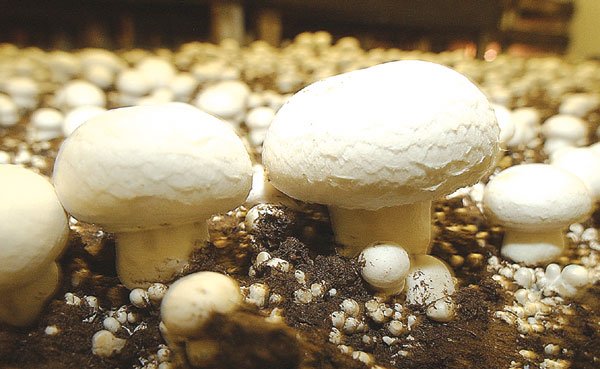Available in every shade from crisp button whites to warm,
sumptuous browns, mushrooms are the unsung heroes of the culinary
world
… well, unless you plan on attending the upcoming Mushroom Mardi
Gras in Morgan Hill. That’s when these small fungi hit the big
time, but there is a lot of time invested in these bad boys before
they hit the supermarket shelves.
Available in every shade from crisp button whites to warm, sumptuous browns, mushrooms are the unsung heroes of the culinary world … well, unless you plan on attending the upcoming Mushroom Mardi Gras in Morgan Hill. That’s when these small fungi hit the big time, but there is a lot of time invested in these bad boys before they hit the supermarket shelves.
From composting, the first stage in mushroom planting, to the final stages of picking and shipping, the process lasts about two months. And as Santa Clara’s second-largest cash crop, mushrooms are worth their weight in gold.
The fungi rake in $46.4 million annually for the Golden State. It’s an industry fueled by companies like Monterey Mushrooms, whose Morgan Hill plant – one of 11 the company owns in the United States and Mexico – employs more than 350 workers and pumps out more than 20 million pounds of mushrooms a year, said Clark Smith, the plant’s general manager.
Mushrooms from this region travel as far west as Phoenix and Salt Lake City in unrefrigerated transport trucks, said Smith, but local buyers get the best these farms have to offer in terms of fresh produce, according to Emily Baird, business affairs manager for Del Fresh Produce, Inc. in Gilroy.
“The mushrooms we harvested this morning are getting packed this afternoon, and they’ll be on the trucks tonight,” said Baird. “They can be on the shelf tomorrow morning.”
Mushrooms are “part of the chain that breaks things down once they’re no longer alive,” said Smith. Mushrooms, which are not plants, lack chlorophyll and so do not grow based on collecting the energy of the sun. Instead, they draw all of their nutrients from the soil.
Growers use items like wheat straw, dried poultry waste, cotton seed meal, gypsum and urea to create the rich, dense compost mushrooms love to feed on. But it takes about one month to decompose properly before it can be laid for the mushrooms, said Baird.
Before these crops can be grown en masse, though, growers must pasteurize the soil around them, said Baird.
“Once the compost is ready, we raise the temperature up to 140 degrees to really make sure we kill any harmful organisms (before planting the mushrooms),” said Baird. “Some people are concerned about (accidentally getting) poisonous mushrooms, but that process kills off any spores that could be harmful, like toadstools.”
Next, farmers fill long tubes or trays with the pasteurized compost mix and sow the mixture with a combination of mushroom spores that have been cooked
onto sterilized grains in a specialized laboratory. This Is quite different from the way mushrooms reproduce in the wild, where they spread by dropping seed spores that then grow into new plants.
“We don’t use just spores because they’re microscopic, and you can’t do that on an industrial level,” said Smith. “The spawn (the spore and grain mixture) is a living culture of mushroom that’s growing on a cooked grain, so we can be sure we’ve gotten it into the soil evenly.”
These grains are allowed to settle in the compost for two to three weeks as the mushroom plants mature.
They’re often kept in temperature-controlled buildings and often covered with a mixture of peat moss and crushed limestone to help keep water levels in the soil consistent, said Baird.
Farmers generally get three flowerings of mushrooms from each crop before the soil is removed from the growing beds, repastuerized and sold as landscaping compost, said Baird and Smith.
“It’s just one long process,” said Smith. “There’s more fresh compost every week, so we keep going.”
What:
Mushroom Mardi Gras
When:
Saturday and Sunday, May 28 and 29,
from 10am to 6pm.
Where:
Downtown Morgan Hill between Main
and Dunne avenues along Monterey Road.
Admission: Free
Picking great mushrooms for yourself
Want a Gourmet magazine-quality looking mushroom with the “Wow” taste to match? Look no further than your grocery store’s produce section said local growers, but know what you’re looking for.
“A consumer should be looking for firmness, color and a lack of bruising,” said Clark Smith, general manager of Monterey Mushrooms’ Morgan Hill plant. “Brightness is an indicator of freshness, so the whiter the mushroom, the better, if you’re talking about average cooking mushrooms.”
Depending on what you’re planning to cook, you may want to inspect the caps of your mushrooms as well. Caps that are still firm and barely blooming will be good to eat raw or excellent cut up in salad, according to Emily Baird, business affairs manager for Del Fresh Produce in Gilroy.
Consumers who see brown spots on their mushrooms after washing can rest assured that these are not bits of dirt, but peat moss stains, said Baird, whose company counts the Safeway stores in Morgan Hill and Gilroy among its customers.
Water content of the mushrooms can vary by season, so if you’re cooking something that’s prone to get soggy – pizza for instance – it’s best to try using older mushrooms, said Baird, as they contain less water.
For an innovative summer dish, try grilling up a portobello mushroom marinated in balsamic vinegar or cut one open and stuff it before throwing it on the grill.
Another option, said Baird, is to try brown mushrooms. These are essentially baby portobellos picked earlier than their burger-sized brethren to allow the larger mushrooms room to grow.
Just don’t get any ideas about harvesting your own, experts say.
“The only safe mushroom is one you buy in the store,” said Baird.














